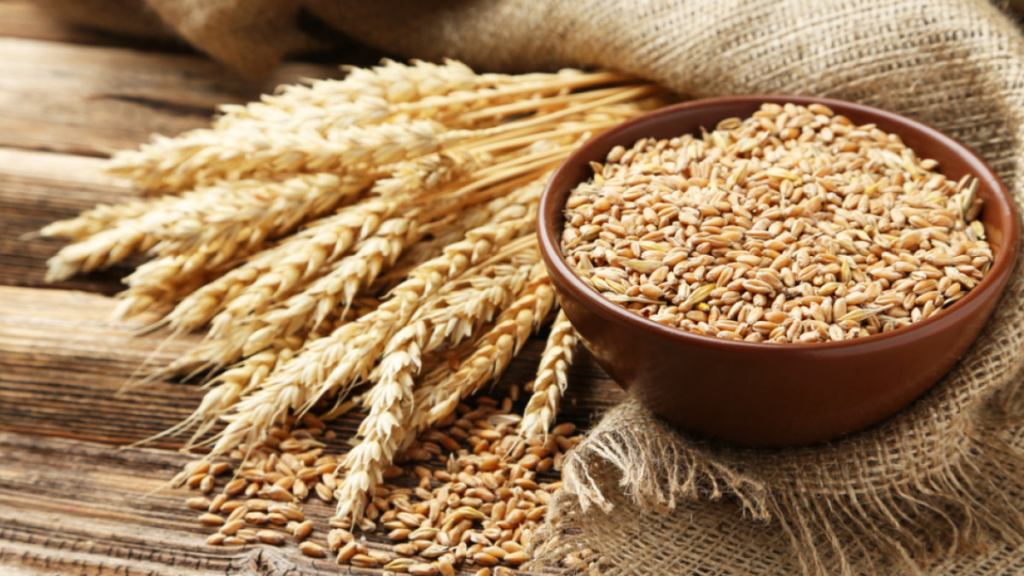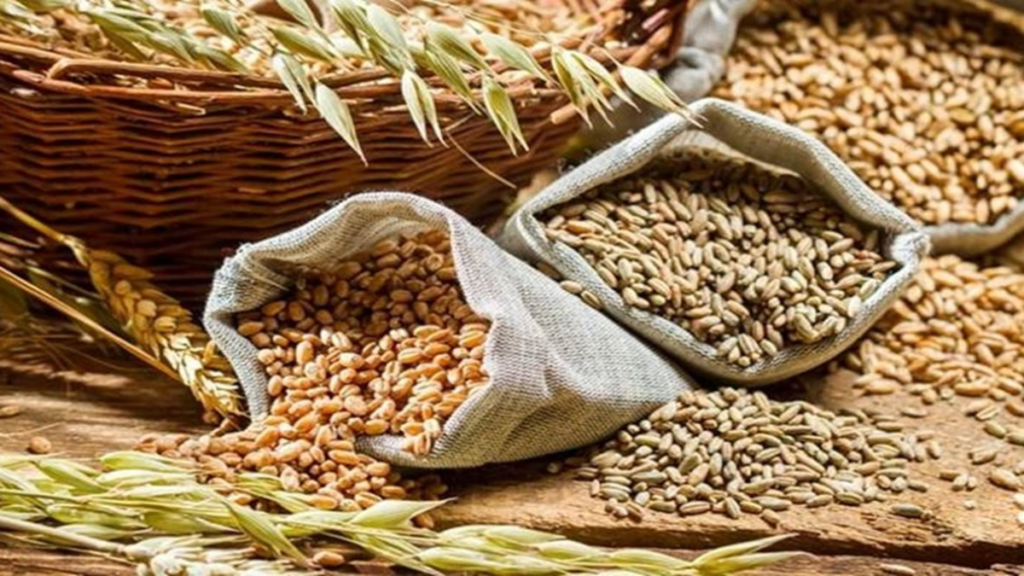Wheat is one of the most adaptable grains regarding nutritional content and health, and it’s easy to find worldwide and add to your everyday diet. Controlling obesity, increasing your body’s metabolism, preventing type 2 diabetes, reducing chronic inflammation, preventing gallstones, preventing breast cancer, and supporting gastrointestinal health in women are just a few of the health benefits.
It also aids in preventing childhood asthma, the prevention of coronary artery disease, the relief of postmenopausal symptoms, and the prevention heart attacks. By having Wheat in your diet regularly, you may reap the benefits of all of its nutrients while also preventing the onset of various diseases.
Wheat is divisive because it includes gluten, a protein that can elicit a damaging immunological reaction in those predisposed to it. On the other hand, whole-grain Wheat can be a good source of antioxidants, vitamins, minerals, and fiber for those who can tolerate it. Like all cereal grains, Wheat is mostly made up of carbohydrates, and starch is the most common carb in plants, accounting for more than 90% of the total carb content in Wheat.
Wheat Nutrition Facts
What is Exactly Wheat?
Wheat is a relatively popular cereal found in practically every dish. This nutritious grain is an essential ingredient of practically any dish, from pasta, bagels, crackers, and bread to cakes and muffins. Its health advantages are mostly determined by the type of Wheat consumed.
Whole Wheat, for example, is regarded as one of the healthiest types of Wheat, but extracted variants of the same grain are less healthful due to the removal of the outer brown covering. Vitamin B3, B2, B1, folic acid, copper, calcium, phosphorus, zinc, fiber, and iron are all found in this layer, and missing out on these might hurt your diet.
Wheat is high in nutrients that are beneficial to your health. It is a fantastic basis for any diet since it contains catalytic components, Vitamin E, Vitamin B, mineral salts, copper, calcium, iodide, magnesium, zinc, potassium, manganese, Sulphur, silicon, chlorine, and arsenic.
Types of Wheat
The grain is commonly consumed in two forms:
- Whole Wheat: If you buy 100% whole wheat products, you are assured of all the nutrients of the bran and the germ, and the endosperm.
- Processed Wheat: Bleached white flour is obtained by processing after 60% extraction from the grain. Usually, the 40% removed – the outer brown layer – contains the highly nutritious bran and the germ of the wheat grain. In making 60% abstraction flour, more than half of the vitamins B1, B2, B3, and E, calcium, phosphorus, folic acid, copper, zinc, iron, and fiber are lost.
What are the Health Benefits of Wheat?
Here are the health benefits of Wheat:
Gut Health
Insoluble fiber is abundant in whole-grain Wheat, concentrated in the bran. Components of wheat bran have been shown in studies to serve as prebiotics, feeding some of the good bacteria in your gut. The majority of the bran, on the other hand, travels nearly unaltered through your digestive system, adding bulk to your stool. Wheat bran may also help to speed up the passage of undigested food through your digestive tract. According to one study, bran can help youngsters avoid constipation. However, depending on the cause of constipation, eating bran may or may not be useful.
Prevention of Colon Cancer
The most common type of digestive tract cancer is colon cancer. Whole grains, including whole Wheat, are linked to a lower risk of colon cancer in observational studies. According to one observational study, persons who eat low-fiber diets could reduce their risk of colon cancer by 40% by eating more fiber. Randomized controlled experiments back this up; however, not all have identified a significant protective impact. Overall, whole wheat is high in fiber and contains several antioxidants and phytonutrients that may help to lower your colon cancer risk.
Celiac Disease
A negative immunological response to gluten defines celiac disease. This disorder affects about 0.5–1% of people in the United States and Europe. Celiac disease causes damage to the small intestine, impairing nutrient absorption. Weight loss, bloating, flatulence, diarrhea, constipation, stomach pain, and exhaustion are common symptoms. Gluten has also been linked to brain abnormalities in celiac disease patients, such as schizophrenia and epilepsy.
May Improve Metabolism
Whole wheat products contain fiber, which helps to speed up the digestive process and enhance overall metabolism. Doctors recommend whole grain bread and other fiber-rich foods. Foods made from refined grains have been found in studies to enhance weight gain and the risk of insulin resistance.
May Promote Women’s Health
Women’s energy and vigor are boosted by whole Wheat. Increased whole-grain consumption raised their energy levels, reduced weight gain, and type 2 diabetes, and kept their BMI low, according to the long-term Women’s Health Initiative Observational Study. According to the research, women who ate more whole grains had a healthier diet and consumed more fruits and vegetables. Folate and vitamin B are found in stone-ground whole-grain products, which may help with pregnancy and breastfeeding issues.
What are the Disadvantages of Wheat?
Although Wheat has a lot of health benefits, it has some disadvantages also:
- The number of people who eat a gluten-free diet outnumbers those with celiac disease. People may mistakenly believe that Wheat and gluten are intrinsically unhealthy, and Wheat or gluten may also produce problems in certain people.
- Irritable bowel syndrome (IBS) is a prevalent disorder marked by abdominal pain, bloating, irregular bowel movements, diarrhea, and constipation. It’s more common in people with anxiety, and a stressful life event usually brings it on. Wheat sensitivity is frequent in patients with IBS.
- A detrimental immune reaction to particular proteins causes food allergy, a widespread illness. Gluten, found in Wheat, is a common allergy that affects about 1% of children and adults who are routinely exposed to airborne wheat dust and are more likely to develop allergies. Wheat dust allergy symptoms include baker’s asthma and nasal irritation.
- Phytic acid (phytate) is found in whole-grain Wheat, inhibiting the absorption of minerals like iron and zinc from the same meal. As a result, it has been labeled as an antinutrient. Antinutrients are rarely a problem for persons who eat a well-balanced diet, but they can be a problem for people who eat cereal grains and legumes.
- Gluten sensitivity that isn’t caused by celiac disease. More people have recently reported symptoms after consuming Wheat, and allergies or autoimmune diseases don’t cause headaches, weariness, and muscle problems.
How Much Wheat Should I Eat a Day?
The amount of whole-grain food that should be consumed daily varies by age, gender, and level of physical activity. Whole grains should account for around half of your total grain intake. Experts recommend consuming 5 to 8 ounces of grains per day, including 3 to 6 ounces of whole grains.
Uses
- Bread, muffins, breakfast cereal like wheat flakes
- Sprouted wheat berries can be used in vegetables and various grain salads.
- Wheat germ: Add it to bread, pastries, cakes, or yogurt for an extra nutrient punch.
- Pizza & pasta
- Wraps & Rotis
Common Wheat vs. Spelt
Spelt is a type of ancient Wheat closely linked to common Wheat. Spelt, which has been grown for thousands of years, has recently gained popularity as a health food. Both whole Wheat and spelt have similar nutritional characteristics, especially in terms of fiber and protein. Still, it depends on which spelt and common wheat cultivars are being compared. However, some minerals, such as zinc, may be higher in spelt.
Research shows that modern Wheat contains fewer nutrients than wide old wheat varieties. spelt is not more advantageous than whole-grain ordinary Wheat, aside from its high mineral content.
Is Wheat Healthier than Rice?
Rice vs. Wheat has been a point of contention for decades. Rice and Wheat are stapling foods in many parts of the world, and they can be eaten for breakfast, lunch, dinner, or all three. Lately, many questions have been raised over the nutritional value of all the edibles, including Rice and Wheat. Although Rice and Wheat have similar carbohydrate and calorie content, their nutritional value differs. Let’s take a look at:
| Rice | Wheat |
| We commonly use polished or white Rice, which is white because the fiber-rich outer covering – husk and bran – has been removed. The majority of micronutrients, such as vitamins and minerals, are washed away during this process. As a result, white Rice is deficient in B vitamins, iron, calcium, and other nutrients. | Whole wheat flour, which is used to make Rotis, is high in fiber, protein, and minerals like iron, calcium, selenium, potassium, and magnesium (unless sieved). |
| Rice is easier to digest because of its starch content. | Wheat digests slowly as compared to Rice. However, due to slow digestion, roti keeps you full for longer. |
| Folate, a water-soluble B-vitamin, is found in both Rice and Wheat. | Wheat has a higher nutritional value than Rice because it contains more proteins and fibers than Rice. |
| Rice provides the same amount of iron as Wheat but has less phosphorus, potassium, and magnesium, and it doesn’t contain any calcium. | Each serving of chapatis provides high calcium, phosphorus, iron, and potassium compared to Rice. |
Best Whole Grains for Weight Loss
Here are the best whole grains for losing weight:
1. Barley
The ancient barley grain is available in flour form, which can be cooked and used in dishes such as warm salads or stir-fried vegetables.
2. Finger Millets
Finger millets are commonly used to prepare rotis, parathas, and now even dosas. It’s a gluten-free grain well-known in the nutrition world for its anti-diabetes and anti-anemia properties. Ragi is high in vitamin D and calcium, making it beneficial to the skin and bones.
3. Brown Rice
Brown rice is a grain you must include in your diet if you have resolved to give up starch in 2019 and lose weight. Brown rice contains complex carbohydrates, phytic acid, and polyphenols, which make it a powerful weapon against blood sugar fluctuations. It’s high in fiber and can help with digestion.
4. Buckwheat
Buckwheat is a gluten-free whole grain that can be used to make rotis, noodles, pancakes, puris, and other dishes. It’s high in fiber and can help you feel more energized. Calcium, magnesium, iron, vitamin C, and other essential vitamins and minerals are abundant.
5. Quinoa
Quinoa is one of the most protein-dense whole grains for weight loss. A 100-gram serving of the grain contains 14 grams of protein and 7 grams of fiber (as per the USDA data). Quinoa caWheateaten with stir-fried vegetables and grilled meats or added to salads. It’s a Wheatsterol-free food grain with a low glycaemic index popular among bodybuilders and slimmers.
Conclusion
Wheat is not only one of the most widely consumed foods on the planet, but it is also one of the most divisive. Gluten intolerance necessitates the Wheatete elimination of Wheat from one’s diet. On the other hand, moderate consumption of fiber-rich whole Wheat may be beneficial to those who can tolerate it, as it may aid digestion and help prevent colon cancer.
Finally, consuming wheat loaves of bread, baked goods, and other wheat products in moderation is unlikely to harm your health.
Gluten, which is found in Wheat, can be problematic. Gluten is a protein that can have negative consequences for some people, and however, most people can eat gluten without any problems.



